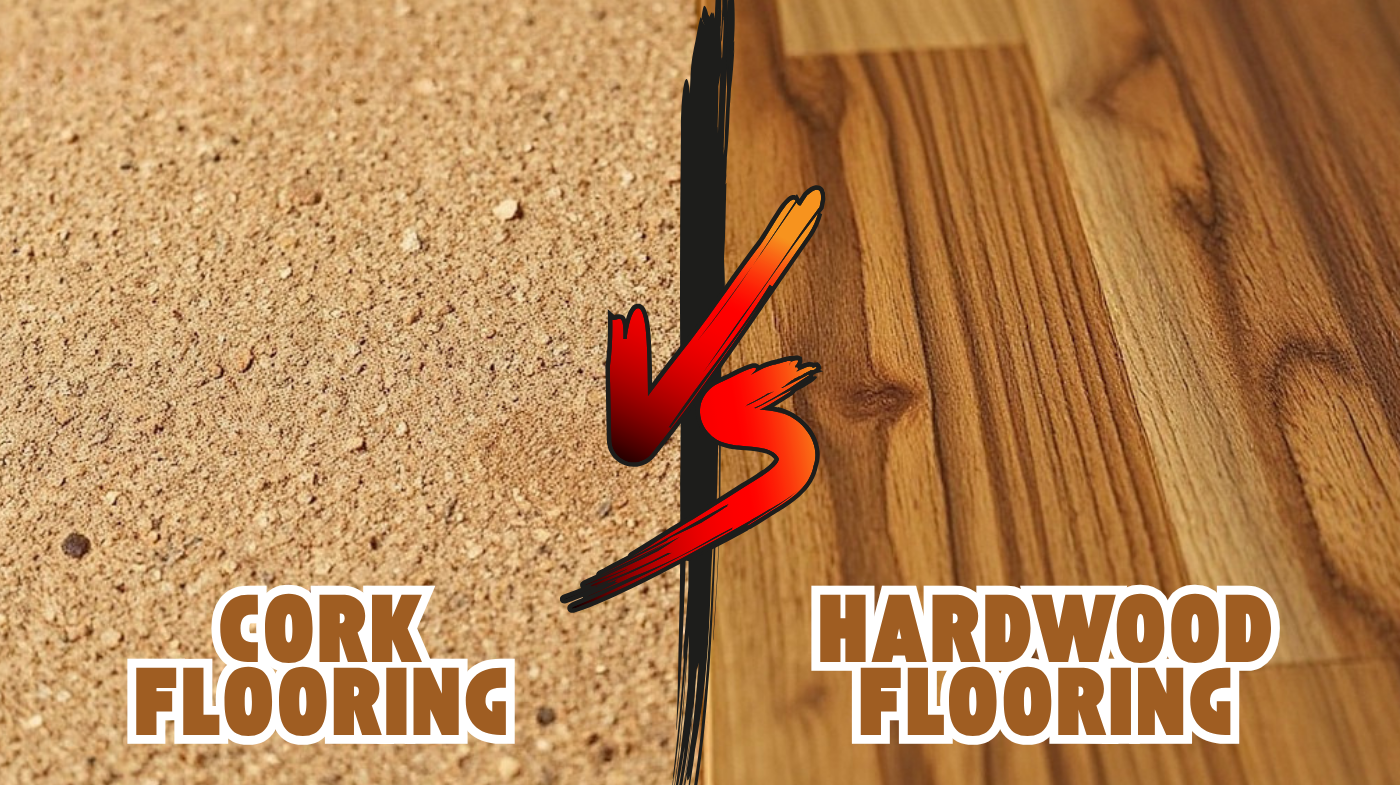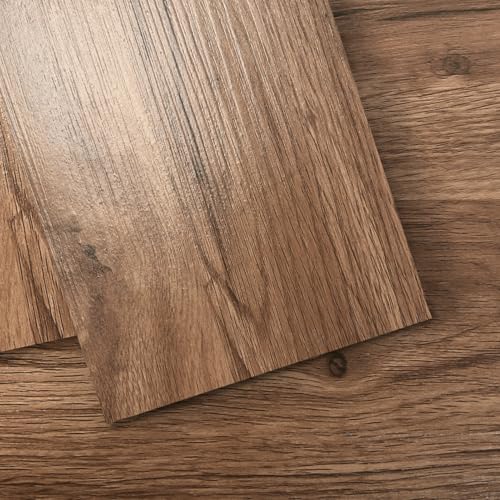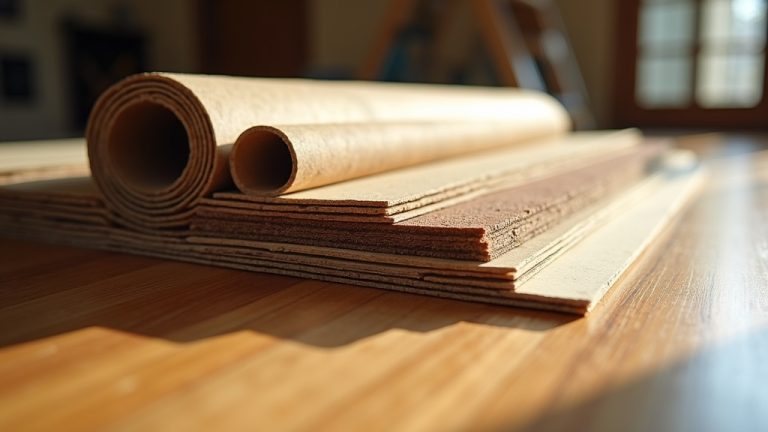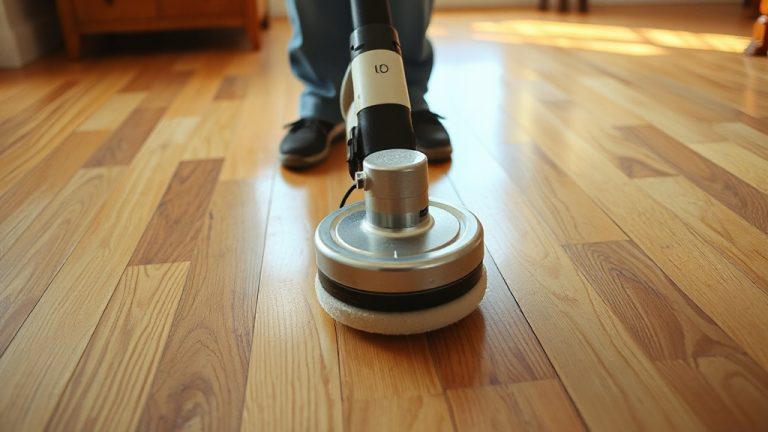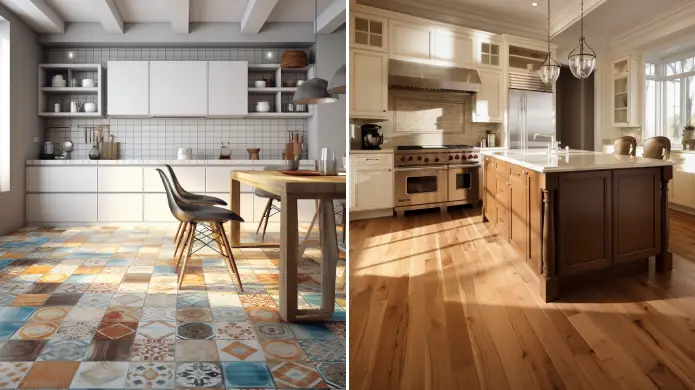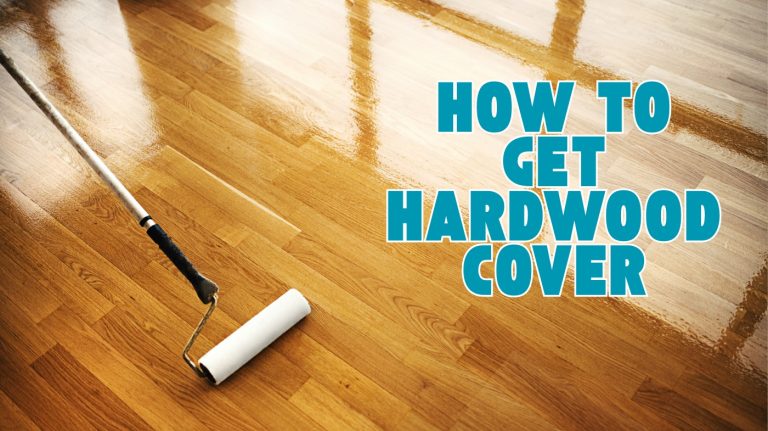Cork Flooring Vs Hardwood Flooring: Finding the Right Fit
When choosing between cork and hardwood flooring, consider your lifestyle and style goals. Cork offers warmth, softness, excellent sound absorption, and eco-friendly appeal with moderate durability and budget-friendly costs.
Hardwood delivers timeless elegance, exceptional durability, and higher resale value but at a steeper price. Each brings unique textures and design versatility cork’s organic patterns versus hardwood’s rich grains.
Understanding their maintenance and installation differences helps you pick the perfect fit to enhance your home’s character and comfort. Explore further to uncover all the details.
- For use under ceramic tile, stone, marble, glued wood flooring and floating floor systems
- Acts as a crack isolation membrane, resisting the transfer of stress cracks up to 1/8″” from…
- Sound absorbing, it reduces sound transmission from the surface of the floor upward, as well as from…
- Stylish – Authentic wood looking and grain texture, adding timeless feature for your home
- Easy DIY – Just peel and stick down on a flat floor for installation, no power tools, no experience,…
- Superior Property – Rigid surface and hard core, 100% waterproof, fire proof, wear resistant,…
Key Takeaways
- Cork flooring offers natural warmth, softness, and superior sound insulation compared to the firmer, cooler feel of hardwood floors.
- Hardwood flooring provides greater durability and longevity, often lasting decades or centuries with refinishing, unlike cork’s shorter lifespan.
- Cork is a sustainable, eco-friendly option harvested without tree harm, while hardwood involves tree cutting and slower regeneration.
- Installation of cork is generally easier with floating click-lock systems, whereas hardwood may require nailing, gluing, or acclimation.
- Hardwood typically commands higher resale value due to its classic appeal, while cork’s market is growing with niche eco-conscious buyers.
Comparison Table Between Cork & Hardwood Flooring
| Aspect | Cork Flooring | Hardwood Flooring |
|---|---|---|
| Comfort | Soft, springy, and cushioned underfoot; reduces fatigue and strain | Firm and solid surface; feels cooler underfoot |
| Sound Insulation | Excellent sound absorption; reduces noise by up to 20–25 dB | Reflects sound; may require underlayment to reduce echo and footstep noise |
| Durability | Moderate; resilient to dents but susceptible to moisture if untreated | High durability; can last decades or centuries with proper care and refinishing |
| Lifespan | Shorter lifespan; may require earlier replacement | Long-lasting; supports multiple refinishing cycles |
| Maintenance | Requires sealing, damp mopping, and use of pH-neutral cleaners | Requires sweeping, wood-safe cleaners, and occasional refinishing |
| Resale Value | Moderate resale appeal; popular with eco-conscious buyers | High resale value; considered prestigious and classic |
| Sustainability | Highly eco-friendly; made from renewable bark, low energy production | Less sustainable; involves tree cutting and slower regeneration |
| Design & Aesthetics | Warm, earthy tones with natural or printed patterns; suits modern/eclectic styles | Rich species and grain choices; suits traditional, rustic, or modern aesthetics |
| Installation | Easier; often uses floating click-lock system | More complex; may require nailing, gluing, or floating methods |
| Radiant Heating Compatibility | Compatible with most systems; check specific product requirements | Engineered hardwood works best; must control humidity and temperature |
| Suitability by Room | Great for bedrooms, kitchens, and living rooms; cozy, quiet, and impact-resistant | Ideal for living rooms and formal areas; elegant but sensitive to moisture |
Durability and Longevity Comparison
While both cork and hardwood flooring offer durability, understanding their distinct characteristics helps you choose the best fit for your lifestyle.
Cork’s unique cellular structure provides resilience against scratches and impacts, with a natural flexibility that cushions and recovers from dents. Quality finishes, like polyurethane, boost its wear and moisture resistance, but untreated cork may struggle in humid or extreme environments.
Additionally, cork flooring is compatible with radiant heat, though it requires verification based on the specific product type. For regular upkeep, using a pH-balanced cleaning solution can help maintain cork’s finish without causing damage.
Hardwood, on the other hand, boasts exceptional longevity and structural strength, capable of lasting decades or even centuries with proper care. It resists superficial scratches but can dent under heavy impact.
Both floors require protective finishes and thoughtful maintenance, yet hardwood’s ability to be refinished multiple times gives it an edge in lifespan. Your choice depends on balancing durability with environmental conditions and maintenance preferences.
Cost Analysis and Value Assessment
Understanding durability sets the stage for evaluating the financial commitment each flooring type demands.
Cork flooring offers lower upfront costs and easier installation, making it budget-friendly. Hardwood, though pricier initially, provides greater longevity and refinishing options, enhancing long-term value. Y
our choice depends on balancing initial investment with maintenance needs and aesthetic goals. Additionally, factors such as environmental conditions can influence the maintenance and lifespan of these flooring materials.
| Aspect | Cork Flooring |
|---|---|
| Upfront Cost | $5–$14.50/sq ft (installed) |
| Maintenance | Sealing, damp mopping, oils |
| Lifespan | Shorter, needs earlier replacement |
| Resale Value | Moderate, eco-friendly appeal |
| Aspect | Hardwood Flooring |
| Upfront Cost | $8–$23/sq ft (installed) |
| Maintenance | Sweeping, refinishing |
| Lifespan | Longer, refinishable |
| Resale Value | High, prestigious appeal |
Comfort and Sound Insulation Differences
Because your flooring choice affects daily comfort and noise levels, it’s important to weigh how cork and hardwood differ in these areas.
Cork’s cellular structure offers a soft, springy feel that cushions your feet, reducing fatigue and joint strain during long periods of standing. It also retains warmth, making it cozy underfoot in cooler months. Additionally, cork provides thermal insulation and comfort that enhances its appeal for comfortable living spaces.
Sound-wise, cork excels by absorbing impact and airborne noise, cutting echoes by 20–25 dB and creating a serene environment. Hardwood floors, however, may require quality underlayment to help mitigate sound reflection and footstep noise.
Hardwood, by contrast, feels firm and cooler, lacking cork’s cushioning. It’s durable and smooth but tends to reflect sound, amplifying footsteps and echoes unless paired with quality underlayment.
While engineered options can improve noise control, cork naturally delivers superior comfort and quieter living spaces without extra additions.
Environmental Impact and Sustainability Factors
When you choose cork flooring, you support sustainability by selecting a product harvested only from bark, allowing cork oak trees to live up to 300 years and regrow their bark every 9 to 12 years. This method boosts carbon absorption by up to five times compared to unharvested trees, turning cork forests into powerful carbon sinks.
Additionally, this harvesting process is carried out by skilled workers who peel the bark without damaging the trees, ensuring the health and longevity of cork oak forests. Cork flooring also requires low-energy production, which significantly reduces environmental impact during manufacturing.
Cork’s low-energy production and biodegradable nature minimize waste and emissions. In contrast, hardwood flooring demands cutting entire trees, leading to deforestation, higher energy use, and slower regeneration.
Cork also repurposes leftover materials and supports biodiversity by preserving forest ecosystems. By opting for cork, you reduce your carbon footprint and promote a closed-loop, eco-friendly flooring solution that benefits both your home and the planet.
Aesthetic and Design Variety
You’ll notice cork’s natural patterns bring warmth with subtle texture, while hardwood offers a rich palette of species and grain variations. Proper application techniques help maintain the beauty and durability of any flooring finish.
Each material lends itself to both traditional and modern styles, letting you tailor your space’s character precisely. Choosing between them means balancing organic softness against classic wood elegance to match your design vision.
Additionally, you can create striking geometric patterns by using cork’s natural variations to add a unique and sophisticated touch to your floors.
Natural Patterns and Textures
While both cork and hardwood flooring offer natural beauty, their patterns and textures create distinctly different visual and tactile experiences that can shape your space’s atmosphere.
Cork’s warm, earthy tones from beige to deep tan feature subtle, irregular grain patterns and a soft, cellular texture that adds warmth underfoot. Its through-body coloration cleverly hides scratches and dirt, maintaining a calm, neutral look even in high-traffic areas.
The natural hues of cork flooring, including tan, golden, and darker variations, bring an organic, natural aesthetic indoors. When installing cork adjacent to hardwood, it is important to consider the proper transition methods to ensure a seamless and durable connection.
Hardwood, by contrast, presents a broader color spectrum and more pronounced grain patterns straight, wavy, or curly that command attention and enrich your room’s character. Hardwood’s smooth, harder texture feels distinctly different beneath your feet.
Species and Grain Options
Although cork and hardwood flooring both bring natural charm to your space, their species and grain options offer distinctly different design possibilities. Cork flooring comes in tiles, planks, and sheets, with grains ranging from agglomerated to linear cuts, plus printed patterns mimicking wood or stone.
You can choose homogeneous or heterogeneous tiles in varied shapes and colors, allowing striking geometric or mosaic designs. Cork flooring is available as solid or engineered products, providing flexibility in installation and durability.
Hardwood flooring, on the other hand, boasts genuine species diversity—from oak’s open grain to maple’s fine texture and natural hues from pale blondes to deep browns. Different cuts like plain-sawn or quarter-sawn reveal unique grain patterns, enhancing each plank’s individuality.
While cork offers versatile printed visuals, hardwood delivers authentic grain depth and species richness, giving your floor an unmistakably natural identity.
Traditional Versus Modern Styles
A floor’s style sets the tone for your entire space, and both cork and hardwood flooring bring unique aesthetic qualities to traditional and modern designs.
When choosing, consider these points:
- Cork suits mid-century modern and casual interiors with its warm, textured look, while hardwood excels in classic, formal settings like Victorian homes. Proper sanding and finishing techniques can enhance hardwood’s natural beauty and ensure lasting elegance.
- Modern cork offers bold colors, geometric patterns, and finishes that mimic concrete or wood, perfect for eclectic or minimalist spaces. Cork is also valued for being a renewable resource that supports sustainable design.
- Hardwood adapts with a variety of species, stains, and plank layouts—from rich traditional darks to whitewashed modern styles. You can customize the color of hardwood floors through staining and refinishing to match any interior palette.
- Engineered hardwood and lacquered cork provide versatile options that combine style with easy installation and maintenance.
Maintenance Requirements and Practical Tips
Because maintaining your floors properly preserves their beauty and longevity, understanding the specific care routines for cork and hardwood is essential.
For cork, sweep or vacuum regularly to avoid abrasive buildup and use pH-neutral, water-based cleaners sparingly never flood the floor. Quickly wipe spills to prevent moisture damage, and place breathable walk-off mats at entrances.
Most cork floors come with a urethane finish that provides long-term wear and scratch resistance. Avoid using stiff brushes or excessive washing to protect the cork’s surface and finish.
For hardwood, sweep with a soft brush or vacuum designed for hard floors, and clean with wood-specific products, avoiding harsh chemicals. Immediately address spills and consider periodic refinishing to maintain the finish. Control moisture carefully and dry immediately after cleaning to prevent buckling or warping.
Use microfiber mops and protective pads under furniture for both types, and maintain humidity levels for hardwood. Testing new cleaners and gentle spot treatments helps preserve cork’s texture, while occasional buffing enhances hardwood’s shine, ensuring your floors stay elegant and durable.
Installation Processes and Considerations
When choosing between cork and hardwood flooring, understanding their distinct installation processes will help you achieve a flawless, long-lasting finish. Cork flooring often employs a floating click-lock system, letting you install without glue or nails, while hardwood may require nailing, gluing, or floating methods, depending on the type.
Here’s what to consider:
- Prepare the subfloor meticulously—clean, dry, level, and stable—to prevent future damage or unevenness.
- For cork, install a moisture barrier on concrete or damp floors; hardwood needs acclimation to the room’s humidity first.
- Lay cork planks from the right corner with expansion gaps; hardwood installation varies but demands precise alignment.
- Use proper tools—rubber mallet, spacers for cork; nail guns or adhesives for hardwood—to ensure a secure fit.
It is also important to address underlying causes such as moisture or subfloor issues before installation to avoid future soft spots or damage. This detail-oriented approach guarantees a polished, enduring surface.
Suitability for Different Living Spaces
Understanding the installation nuances sets the foundation, but selecting the right flooring also means matching it to your living spaces’ unique demands.
For living and family rooms, hardwood offers timeless elegance, perfect for formal settings, while cork’s softness and sound absorption create a cozy, quieter atmosphere ideal for active households. Its natural thermal insulation also helps maintain a comfortable room temperature.
In kitchens, cork’s cushioning eases long standing and resists impacts, though it needs sealing against moisture. Hardwood provides classic beauty but demands care to avoid water damage. Promptly drying any spills is important to prevent moisture-related issues.
Bedrooms benefit from cork’s warmth and noise reduction, enhancing comfort, whereas hardwood adds sophistication but feels cooler underfoot. For moisture-prone areas, cork with proper sealing can work, but hardwood generally suits drier spaces.
Long-Term Investment and Resale Implications
When you invest in hardwood flooring, you’re choosing timeless elegance that often boosts your home’s resale value and appeals to a wide range of buyers. Hardwood flooring is known for its ability to last decades or centuries with proper care and refinishing, which can enhance its long-term value.
Cork flooring offers eco-friendly charm but may not deliver the same long-term investment benefits or market demand. Understanding how each material holds up over time helps you make a decision that aligns with both your lifestyle and financial goals.
Resale Value Impact
Although both cork and hardwood flooring offer distinct advantages, their impact on resale value varies substantially based on buyer preferences and market trends.
When considering resale, you’ll want to weigh:
- Hardwood floors carry traditional appeal and luxury, often recouping more of your investment through durability and refinish options.
- Cork’s eco-friendly nature and excellent insulation attract buyers prioritizing sustainability and comfort, increasing its niche appeal. The global cork flooring market is projected to grow at a steady 6% CAGR, reflecting its rising acceptance.
- Hardwood’s established market demand ensures consistent resale premiums, while cork’s growing popularity signals rising future value.
- Maintenance factors affect cork’s resale perception; proper care is essential to avoid negative buyer impressions.
Investment Longevity Benefits
Choosing flooring with long-term investment benefits means considering durability, maintenance, and how well it holds value over time. Hardwood flooring, with its ability to last decades even centuries with proper care and multiple refinishing cycles, offers exceptional longevity and enduring appeal.
Its hardness resists heavy foot traffic, making it a resilient choice for long-term value. Cork flooring, while durable and softer underfoot, typically requires replacement sooner and has fewer refinishing opportunities.
However, cork’s lower upfront cost and easier tile replacement can be attractive for certain budgets. Its cellular structure provides comfort, thermal, and sound insulation, which adds value in terms of living quality.
Frequently Asked Questions
Can Cork or Hardwood Flooring Affect Indoor Air Quality?
You’ll find that your flooring choice directly influences indoor air quality. Materials releasing volatile organic compounds (VOCs) can compromise air purity, affecting your health.
Some flooring options naturally repel microbes and allergens, creating a fresher environment. Others may require careful selection of finishes and maintenance to reduce pollutants.
Are There Allergy Concerns With Cork Versus Hardwood Flooring?
They say, “Don’t judge a book by its cover,” and allergy concerns are no different. You’ll find cork naturally repels dust mites, mold, and bacteria thanks to suberin, making your space healthier with less effort.
Hardwood floors, while sleek, can harbor allergens in cracks and emit VOCs if not sealed well. So, if you want comfort with allergy defense, cork’s your friend—but both need proper sealing and cleaning to shine.
How Do Cork and Hardwood Flooring React to Pet Claws?
You’ll find that pet claws can be tough on floors, but cork’s elasticity helps it bounce back from scratches and dents, offering a forgiving surface that minimizes visible damage. Hardwood, while beautiful, tends to show claw marks more readily, risking scratches and finish wear over time.
Regular nail trimming and protective measures are essential for both, but cork’s resilience often makes it a more pet-friendly choice if you want to maintain your floor’s elegant look.
Can Either Flooring Type Be Installed Over Radiant Heating Systems?
Wondering if your flooring can handle radiant heat? Both cork and hardwood can be installed over radiant heating systems, but you’ll want to be mindful. Cork thrives with hydronic systems and prefers floating installations, maintaining stability and comfort.
Hardwood, especially engineered, works well too but demands careful acclimation and humidity control to avoid warping. Keep the surface temperature under 85°F, and you’ll enjoy cozy warmth without compromising beauty.
What Are the Common Repair Options for Damaged Cork or Hardwood?
When your floor gets damaged, you can tackle minor scratches with color-matched markers or crayons to blend them seamlessly.
For deeper dents, use repair kits or wood putty, then sand lightly to smooth the surface before refinishing. If damage is extensive, replacing individual tiles or boards is a smart choice.
Make the Right Choice: Flooring That Reflects You and Your Home
Choosing between cork and hardwood flooring is like picking the perfect outfit—it depends on your style, comfort needs, and lifestyle. Cork offers cozy warmth and eco-friendly charm, while hardwood brings timeless elegance and durability.
Consider your space’s demands and personal taste carefully. With the right choice, your floors will not only support your daily life but also elevate your home’s beauty and value for years.
- Thickness: For general purpose applications
- Size: Covers 32 square feet
- Easy to Cut & Install – Mount directly to wall or glue to backer board; can be stained or painted
- Stylish – Authentic wood looking and grain texture, adding timeless feature for your home!
- Easy DIY – Just peel and stick down on the floor for installation, no power tools, no experience
- Superior Property – Rigid surface and hard core, 100% waterproof, fire proof, wear resistant,…
Last update on 2025-12-31 / Affiliate links / Images from Amazon Product Advertising API

